
Seeing how 2021 is being billed as the year of the fruits and vegetables, it is only fitting that we start the year off with a squabble of sorts.
Domestic blueberry shippers are growing more and more concerned with the increasing level of imported blueberries being used. The rub revolves around plunging markets due to an overlap of domestic and import products. While the majority of imported blueberries come from Chile & Peru, Mexico is the country currently in the grower’s crosshairs.
Blue Book has teamed with Agtools Inc., BB #:355102 the data analytic service for the produce industry, to see what the data shows about a fruit or vegetable in 2021.
Let’s look at the blueberry season as a whole to begin with, to get a better understanding of how the season works between domestic and import.
Below shows total U.S. blueberry volume over the last 5 years.
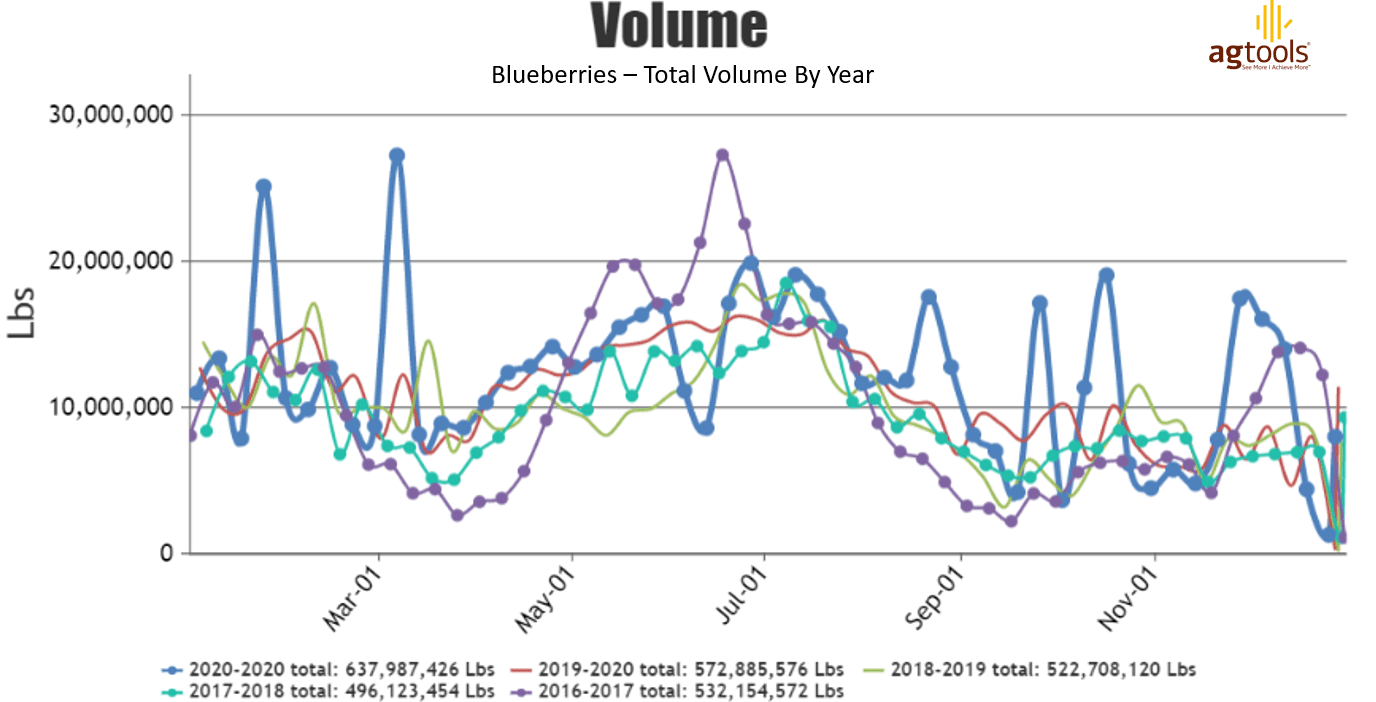
Volume is up over 16 percent since the 2016 season and has grown consistently the last four years. Breaking it down further, we can see the top producing regions blueberries came from in 2020:

At first glance, it would appear that there is very little overlap between the domestic and import seasons. However, when we start to look at market share, a different story arises. Look at the chart below.
Domestic share of the market has dropped a few percentage points to imports during peak growing season, however, it still maintains the lions share (nearly 80 percent) of the market.

Combined with import season, domestic volume has held fairy consistent, while the import season has picked up the majority of the volume needs based on the changing consumer purchasing frequency.
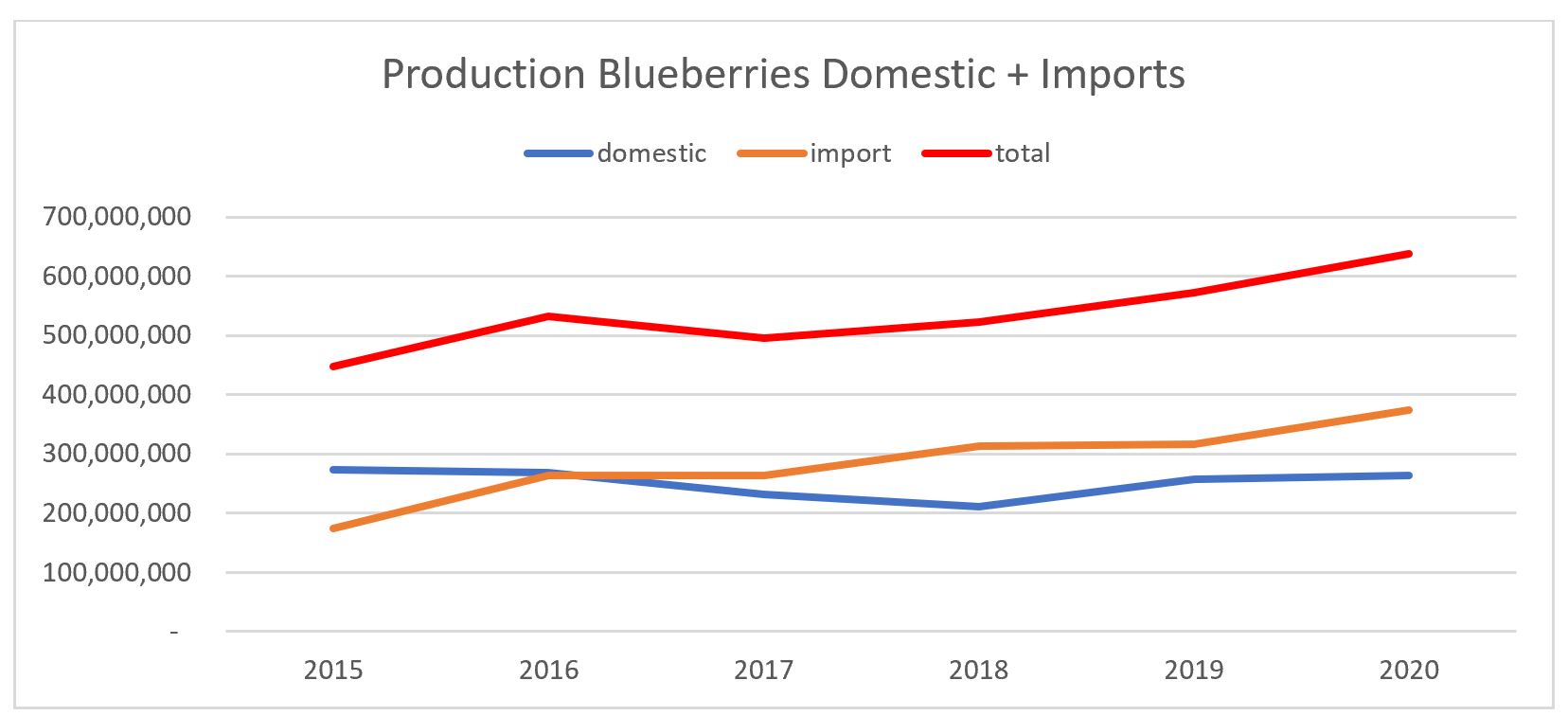
So where does the concern lie? Mexico. While Chile and Peru continue to supply the majority of needs for the import season, Mexico is starting to creep into the domestic growing season.
The impact is lower prices and lower returns to the farmers, causing many long-standing blueberry growers concerns around the ability to survive if Mexico continues to drive the market south.
Look below at the top 10 volume producing regions in 2010, 2015 and 2020. Mexico doesn’t show up until 2020 when it ranks 3rd out of all regions bringing volume into the U.S.
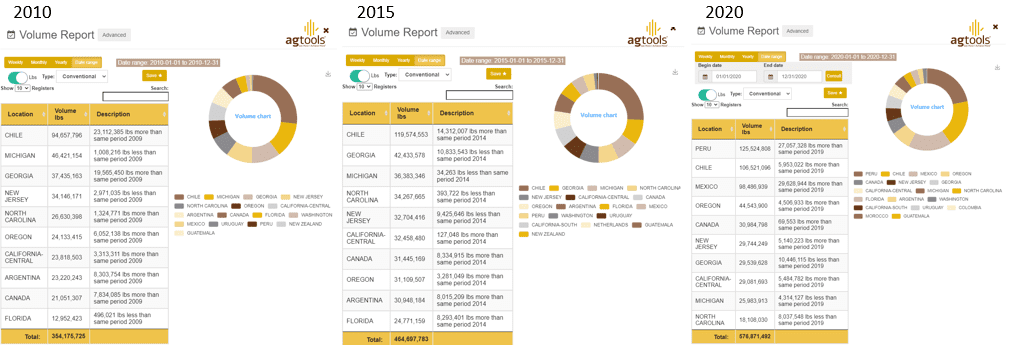
In 2010, Mexico made up 4.7 percent of the total volume used in the U.S. In 2020 that number had grown to 17.1 percent but look a little further at what statistics don’t show you.
Look at the point in time when volume drops below 1 million pounds at the beginning of the domestic season. Each year gets later and later, intruding further into the domestic season.
Five years ago, it dropped below the mark May 1st, while last year volume exceeded the mark through mid-June.

Now look at later in the year as the domestic season is winding down, Mexico is exceeding the 1-million-pound mark by early October (2020) instead of early December, as it did in 2015.
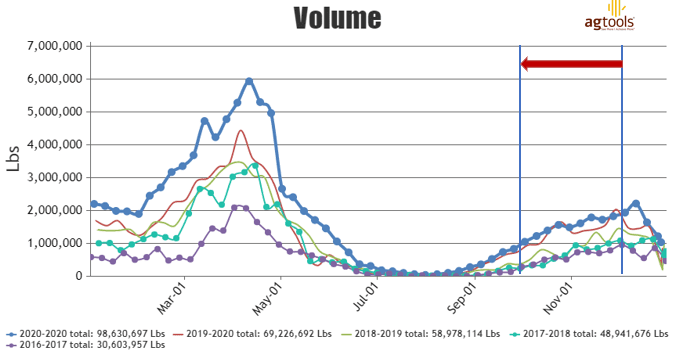
In the Report on Seasonal and Perishable Products in U.S. Commerce, Charles Hall of the Georgia Fruit and Vegetable Growers Association testified: “Over the past twenty years, imports of fresh produce from Mexico have grown tremendously … The pattern has now shifted from undercutting our growers’ financial and competitive health, to threatening our industry’s very survival.”
Bill Brim of Lewis Taylor Farms, a blueberry grower in Georgia said in the same report, “In 2015 when we began to see markets and prices change due to … the increase in Mexican imports, by 2018, the import pressure was so strong that we almost had to shut down. We are barely holding on today.”
Look at Georgia volume in 2015 compared to Mexico:
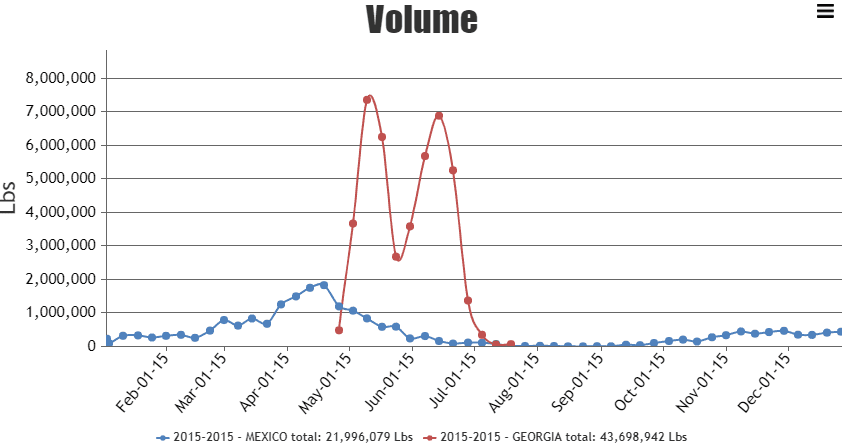
Now look at it in 2020:
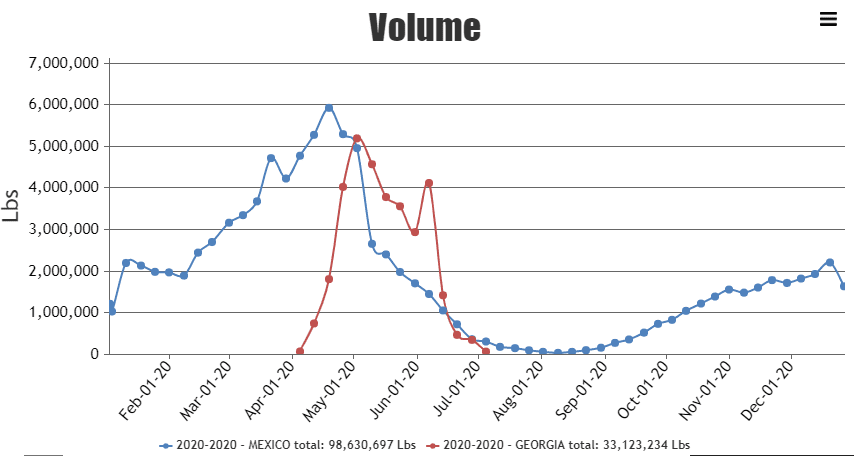
One suggested item in the same report calls for more retail support during the domestic season. However, when we look at retail pricing on blueberries in 4 major regions, the domestic season is the most aggressive period of the year with the exception of the Northeast.
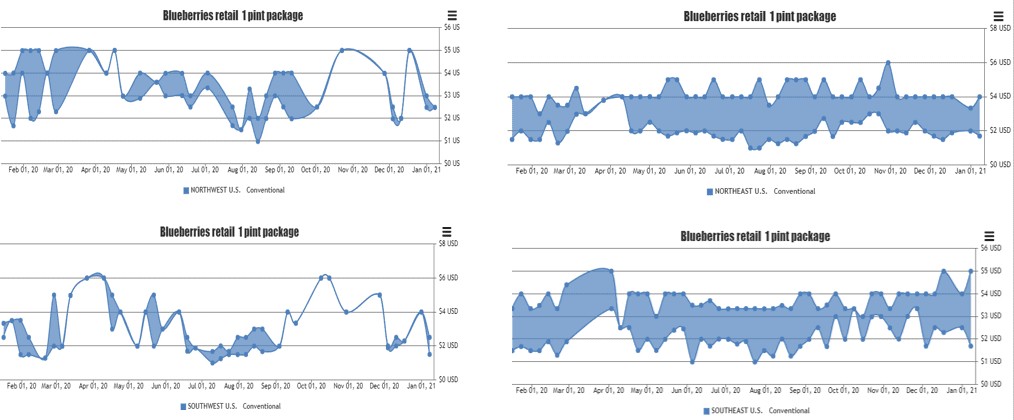
So where does the answer lie?
Like most arguments, somewhere in the middle. While a case can certainly be made for the domestic growers, the bottom line is they cannot handle the increasing consumer demand for year-round supplies, and imports will continue to play an important part of the solution.
However, as Mexico continues to squeeze the domestic season from both ends, it will certainly be something to keep an eye on in this year of fruits and vegetables.
Seeing how 2021 is being billed as the year of the fruits and vegetables, it is only fitting that we start the year off with a squabble of sorts.
Domestic blueberry shippers are growing more and more concerned with the increasing level of imported blueberries being used. The rub revolves around plunging markets due to an overlap of domestic and import products. While the majority of imported blueberries come from Chile & Peru, Mexico is the country currently in the grower’s crosshairs.
Blue Book has teamed with Agtools Inc., BB #:355102 the data analytic service for the produce industry, to see what the data shows about a fruit or vegetable in 2021.
Let’s look at the blueberry season as a whole to begin with, to get a better understanding of how the season works between domestic and import.
Below shows total U.S. blueberry volume over the last 5 years.

Volume is up over 16 percent since the 2016 season and has grown consistently the last four years. Breaking it down further, we can see the top producing regions blueberries came from in 2020:

At first glance, it would appear that there is very little overlap between the domestic and import seasons. However, when we start to look at market share, a different story arises. Look at the chart below.
Domestic share of the market has dropped a few percentage points to imports during peak growing season, however, it still maintains the lions share (nearly 80 percent) of the market.

Combined with import season, domestic volume has held fairy consistent, while the import season has picked up the majority of the volume needs based on the changing consumer purchasing frequency.

So where does the concern lie? Mexico. While Chile and Peru continue to supply the majority of needs for the import season, Mexico is starting to creep into the domestic growing season.
The impact is lower prices and lower returns to the farmers, causing many long-standing blueberry growers concerns around the ability to survive if Mexico continues to drive the market south.
Look below at the top 10 volume producing regions in 2010, 2015 and 2020. Mexico doesn’t show up until 2020 when it ranks 3rd out of all regions bringing volume into the U.S.

In 2010, Mexico made up 4.7 percent of the total volume used in the U.S. In 2020 that number had grown to 17.1 percent but look a little further at what statistics don’t show you.
Look at the point in time when volume drops below 1 million pounds at the beginning of the domestic season. Each year gets later and later, intruding further into the domestic season.
Five years ago, it dropped below the mark May 1st, while last year volume exceeded the mark through mid-June.

Now look at later in the year as the domestic season is winding down, Mexico is exceeding the 1-million-pound mark by early October (2020) instead of early December, as it did in 2015.

In the Report on Seasonal and Perishable Products in U.S. Commerce, Charles Hall of the Georgia Fruit and Vegetable Growers Association testified: “Over the past twenty years, imports of fresh produce from Mexico have grown tremendously … The pattern has now shifted from undercutting our growers’ financial and competitive health, to threatening our industry’s very survival.”
Bill Brim of Lewis Taylor Farms, a blueberry grower in Georgia said in the same report, “In 2015 when we began to see markets and prices change due to … the increase in Mexican imports, by 2018, the import pressure was so strong that we almost had to shut down. We are barely holding on today.”
Look at Georgia volume in 2015 compared to Mexico:

Now look at it in 2020:

One suggested item in the same report calls for more retail support during the domestic season. However, when we look at retail pricing on blueberries in 4 major regions, the domestic season is the most aggressive period of the year with the exception of the Northeast.

So where does the answer lie?
Like most arguments, somewhere in the middle. While a case can certainly be made for the domestic growers, the bottom line is they cannot handle the increasing consumer demand for year-round supplies, and imports will continue to play an important part of the solution.
However, as Mexico continues to squeeze the domestic season from both ends, it will certainly be something to keep an eye on in this year of fruits and vegetables.
Matt DeBoer is senior vice president of Agtools Retail Segment Sales. He has over 20 years in the produce industry from the sourcing side to the retail segment, and he is a diehard Minnesota Vikings fan.













